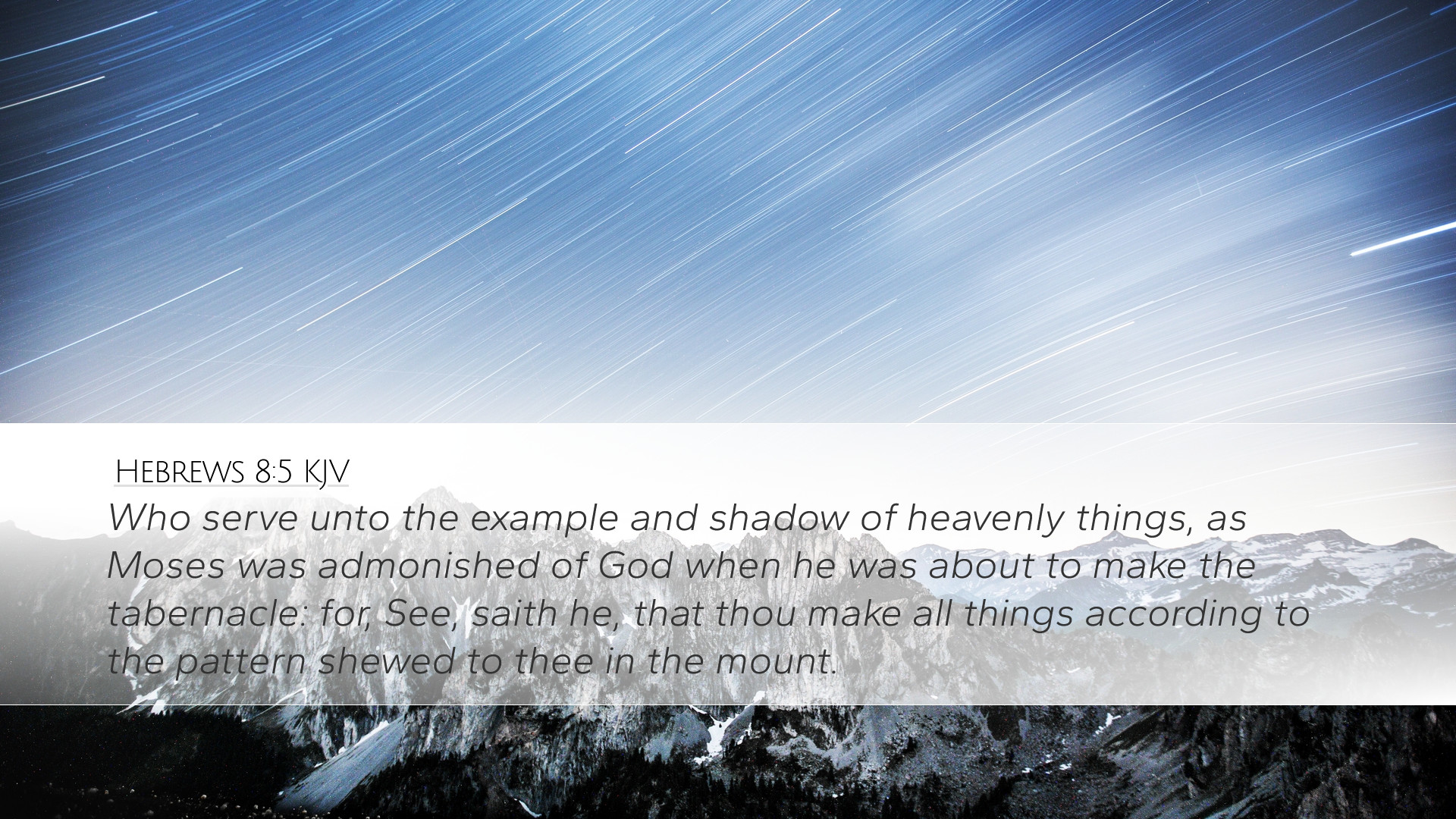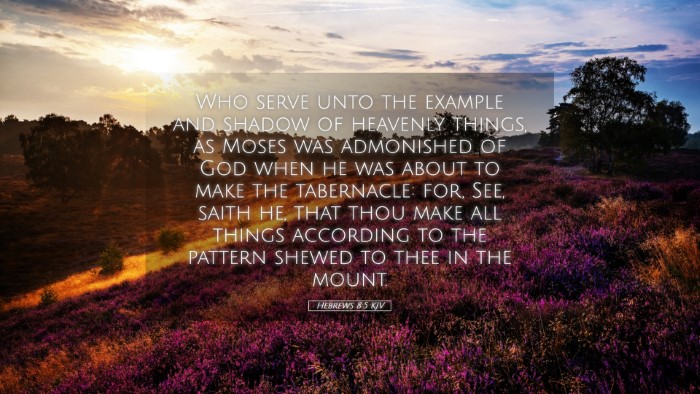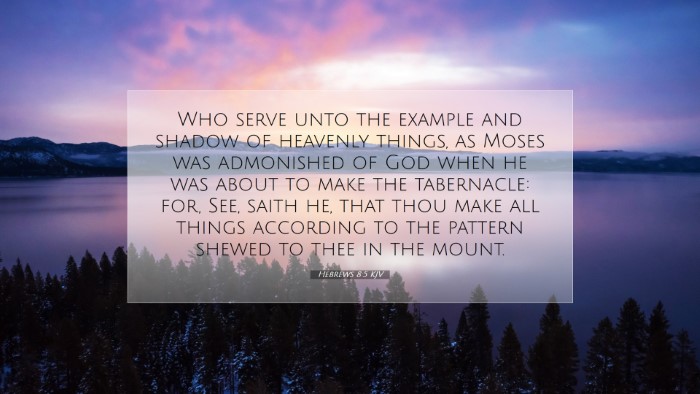Old Testament
Genesis Exodus Leviticus Numbers Deuteronomy Joshua Judges Ruth 1 Samuel 2 Samuel 1 Kings 2 Kings 1 Chronicles 2 Chronicles Ezra Nehemiah Esther Job Psalms Proverbs Ecclesiastes Song of Solomon Isaiah Jeremiah Lamentations Ezekiel Daniel Hosea Joel Amos Obadiah Jonah Micah Nahum Habakkuk Zephaniah Haggai Zechariah MalachiHebrews 8:5
Hebrews 8:5 KJV
Who serve unto the example and shadow of heavenly things, as Moses was admonished of God when he was about to make the tabernacle: for, See, saith he, that thou make all things according to the pattern shewed to thee in the mount.
Hebrews 8:5 Bible Commentary
Commentary on Hebrews 8:5
Verse: "Who serve unto the example and shadow of heavenly things, as Moses was admonished of God when he was about to make the tabernacle: for, See, saith he, that thou make all things according to the pattern shewed to thee in the mount."
Introduction
The verse under consideration, Hebrews 8:5, highlights a crucial principle in the understanding of the Old Testament sacrificial system and its relationship to the New Covenant established in Christ. This verse emphasizes the significance of patterns and types as seen in the ritual worship of the Israelites. The commentary draws insights from renowned public domain theologians to expound upon the depth of meaning contained in this passage.
Context of Hebrews 8:5
In the preceding chapters, the author of Hebrews articulates the superiority of Christ as a High Priest, contrasting this with the Levitical priesthood. Chapter 8 introduces the concept of a new covenant, referencing Jeremiah's prophecy. Understanding the role and purpose of earthly priests and their service is paramount for comprehending the relationship between the heavenly and earthly sanctuaries.
Moses and the Divine Pattern
Insights from Matthew Henry:
- Henry emphasizes that the service of the priests under the Mosaic law is symbolic, serving as a "shadow" of the true realities in Heaven.
- He underscores that God specifically instructed Moses to follow the divinely established pattern, illustrating the care and precision required in worship.
Insights from Albert Barnes:
- Barnes notes the importance of "example" and "shadow" in this context. He posits that the earthly tabernacle and its rituals were designed to prepare the people for the coming of Christ.
- He points out that the term "pattern" shows God's intention for worship to be carried out according to His will and purposes.
Insights from Adam Clarke:
- Clarke elaborates on the admonition given to Moses, emphasizing the seriousness of adhering to the prescribed pattern laid out by God.
- He suggests that the dedications and rituals of the tabernacle were not merely historical but were infused with theological significance, foreshadowing Christ.
The Significance of "Shadow" and "Pattern"
The concepts of "shadow" and "pattern" are critical to understanding the transitional nature of the Old Covenant to the New Covenant. These terms reflect the teaching that the Mosaic Law and its practices were designed to point forward to Jesus Christ.
The Role of the "Shadow"
Matthew Henry's Perspective: Henry conveys that the "shadow" represents the anticipatory nature of the Old Testament rituals. He argues that these rituals prepared the way for the fulfillment found in the New Covenant.
The Importance of the "Pattern"
Albert Barnes' Commentary: Barnes expounds the significance of the "pattern" that God showed to Moses, emphasizing the deliberate and purposeful design in the worship practices established in the tabernacle.
Theological Implications
Understanding Hebrews 8:5 opens doors to several theological reflections:
- Prefiguration of Christ: The tabernacle's design and the priestly service were prefigurations of the ultimate sacrifice of Christ, as the true High Priest.
- Divine Authority in Worship: The call for obedience to divine instruction in worship highlights God’s sovereignty and authority over how He is approached.
- The Transition to a New Covenant: This passage sets the stage for understanding the shift from the Old Covenant, characterized by law and sacrifice, to the New Covenant, characterized by Christ's atonement.
Practical Application
For pastors, students, theologians, and scholars, this commentary on Hebrews 8:5 brings valuable lessons:
- Understanding Worship: Worship should always reflect the character and interests of God, as exemplified in the instructions given to Moses.
- Recognizing Christ's Fulfillment: The Old Testament practices were not merely traditions but foundational truths that find their fulfillment in Christ.
- Teaching the Transition: A well-rounded theological education includes understanding the continuity and discontinuity between the covenants.
Conclusion
Hebrews 8:5 serves as a profound reminder of the continuity between the old and new covenants. The divine order and pattern established in the Old Testament provide a framework for understanding the sufficiency of Christ's priestly ministry. The insights provided by the commentaries of Matthew Henry, Albert Barnes, and Adam Clarke offer rich theological and practical implications for those engaged in the study and proclamation of God's Word.


